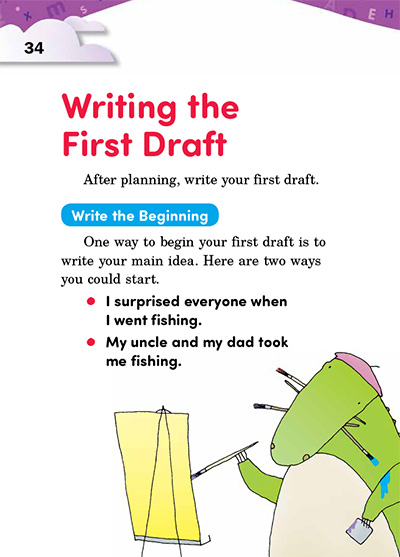Page 034 from

Start-Up Activity
When students write a first draft, they connect the ideas and details that they collected during prewriting. Or to extend the comparison from the notes for page 32, writing a first draft is like putting together the parts for a peanut butter and jelly sandwich. However, a first draft is just the first look at a developing writing idea rather than a finished product.
This chapter provides tips for writing the beginning, middle, and ending parts of a draft. Page 34 gives two ways to begin a first draft. Emphasize that students should try to make their beginnings interesting and fun to read.
Have students practice writing interesting beginnings for a writing topic of their choice, perhaps one they chose during prewriting. Encourage them to model the sample beginnings on this page, using their own topics. Demonstrate sentence modeling as needed.
Think About It
“I suffer through the first draft, but one that’s complete I have lots of fun with my characters.”
—Judy Blume

Start-Up Activity
When students write a first draft, they connect the ideas and details that they collected during prewriting. Or to extend the comparison from the notes for page 32, writing a first draft is like putting together the parts for a peanut butter and jelly sandwich. However, a first draft is just the first look at a developing writing idea rather than a finished product.
This chapter provides tips for writing the beginning, middle, and ending parts of a draft. Page 34 gives two ways to begin a first draft. Emphasize that students should try to make their beginnings interesting and fun to read.
Have students practice writing interesting beginnings for a writing topic of their choice, perhaps one they chose during prewriting. Encourage them to model the sample beginnings on this page, using their own topics. Demonstrate sentence modeling as needed.
Think About It
“I suffer through the first draft, but one that’s complete I have lots of fun with my characters.”
—Judy Blume

